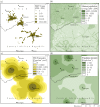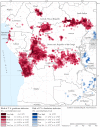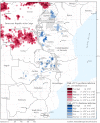Estimating and mapping the population at risk of sleeping sickness
- PMID: 23145192
- PMCID: PMC3493382
- DOI: 10.1371/journal.pntd.0001859
Estimating and mapping the population at risk of sleeping sickness
Abstract
Background: Human African trypanosomiasis (HAT), also known as sleeping sickness, persists as a public health problem in several sub-Saharan countries. Evidence-based, spatially explicit estimates of population at risk are needed to inform planning and implementation of field interventions, monitor disease trends, raise awareness and support advocacy. Comprehensive, geo-referenced epidemiological records from HAT-affected countries were combined with human population layers to map five categories of risk, ranging from "very high" to "very low," and to estimate the corresponding at-risk population.
Results: Approximately 70 million people distributed over a surface of 1.55 million km(2) are estimated to be at different levels of risk of contracting HAT. Trypanosoma brucei gambiense accounts for 82.2% of the population at risk, the remaining 17.8% being at risk of infection from T. b. rhodesiense. Twenty-one million people live in areas classified as moderate to very high risk, where more than 1 HAT case per 10,000 inhabitants per annum is reported.
Discussion: Updated estimates of the population at risk of sleeping sickness were made, based on quantitative information on the reported cases and the geographic distribution of human population. Due to substantial methodological differences, it is not possible to make direct comparisons with previous figures for at-risk population. By contrast, it will be possible to explore trends in the future. The presented maps of different HAT risk levels will help to develop site-specific strategies for control and surveillance, and to monitor progress achieved by ongoing efforts aimed at the elimination of sleeping sickness.
Conflict of interest statement
The authors have declared that no competing interests exist.
Figures





Similar articles
-
The Atlas of human African trypanosomiasis: a contribution to global mapping of neglected tropical diseases.Int J Health Geogr. 2010 Nov 1;9:57. doi: 10.1186/1476-072X-9-57. Int J Health Geogr. 2010. PMID: 21040555 Free PMC article.
-
The elimination of human African trypanosomiasis: Monitoring progress towards the 2021-2030 WHO road map targets.PLoS Negl Trop Dis. 2024 Apr 16;18(4):e0012111. doi: 10.1371/journal.pntd.0012111. eCollection 2024 Apr. PLoS Negl Trop Dis. 2024. PMID: 38626188 Free PMC article.
-
Human African trypanosomiasis in the Democratic Republic of the Congo: disease distribution and risk.Int J Health Geogr. 2015 Jun 6;14:20. doi: 10.1186/s12942-015-0013-9. Int J Health Geogr. 2015. PMID: 26047813 Free PMC article.
-
Priorities for the elimination of sleeping sickness.Adv Parasitol. 2012;79:299-337. doi: 10.1016/B978-0-12-398457-9.00004-4. Adv Parasitol. 2012. PMID: 22726645 Review.
-
Clinical and Neuropathogenetic Aspects of Human African Trypanosomiasis.Front Immunol. 2019 Jan 25;10:39. doi: 10.3389/fimmu.2019.00039. eCollection 2019. Front Immunol. 2019. PMID: 30740102 Free PMC article. Review.
Cited by
-
The miRNA and mRNA Signatures of Peripheral Blood Cells in Humans Infected with Trypanosoma brucei gambiense.PLoS One. 2013 Jun 27;8(6):e67312. doi: 10.1371/journal.pone.0067312. Print 2013. PLoS One. 2013. PMID: 23826264 Free PMC article.
-
Treating cattle to protect people? Impact of footbath insecticide treatment on tsetse density in Chad.PLoS One. 2013 Jun 14;8(6):e67580. doi: 10.1371/journal.pone.0067580. Print 2013. PLoS One. 2013. PMID: 23799148 Free PMC article.
-
Synthesis and Biological Activity of Sterol 14α-Demethylase and Sterol C24-Methyltransferase Inhibitors.Molecules. 2018 Jul 17;23(7):1753. doi: 10.3390/molecules23071753. Molecules. 2018. PMID: 30018257 Free PMC article. Review.
-
Antitrypanosomal Effects of Zanthoxylum zanthoxyloides (Lam.) Zepern. & Timler Extracts on African Trypanosomes.Evid Based Complement Alternat Med. 2019 Jul 4;2019:1730452. doi: 10.1155/2019/1730452. eCollection 2019. Evid Based Complement Alternat Med. 2019. PMID: 31354849 Free PMC article.
-
Through the dark continent: African trypanosome development in the tsetse fly.Front Cell Infect Microbiol. 2013 Sep 18;3:53. doi: 10.3389/fcimb.2013.00053. eCollection 2013. Front Cell Infect Microbiol. 2013. PMID: 24066283 Free PMC article. Review.
References
-
- WHO (1998) Control and surveillance of African trypanosomiasis. Geneva: World Health Organization. Available from: http://whqlibdoc.who.int/trs/WHO_TRS_881.pdf. - PubMed
-
- WHO (2002) WHO programme to eliminate sleeping sickness - Building a global alliance. Geneva: World Health Organization. Available from: http://whqlibdoc.who.int/hq/2002/WHO_CDS_CSR_EPH_2002.13.pdf.
-
- WHO (2012) Accelerating work to overcome neglected tropical diseases: a roadmap for implementation. Geneva: World Health Organization. Available from: http://whqlibdoc.who.int/hq/2012/WHO_HTM_NTD_2012.1_eng.pdf.
-
- WHO (1986) Epidemiology and control of African trypanosomiasis. Geneva: World Health Organization. Available from: http://whqlibdoc.who.int/trs/WHO_TRS_739.pdf. - PubMed
Publication types
MeSH terms
Grants and funding
LinkOut - more resources
Full Text Sources
Other Literature Sources
Medical

